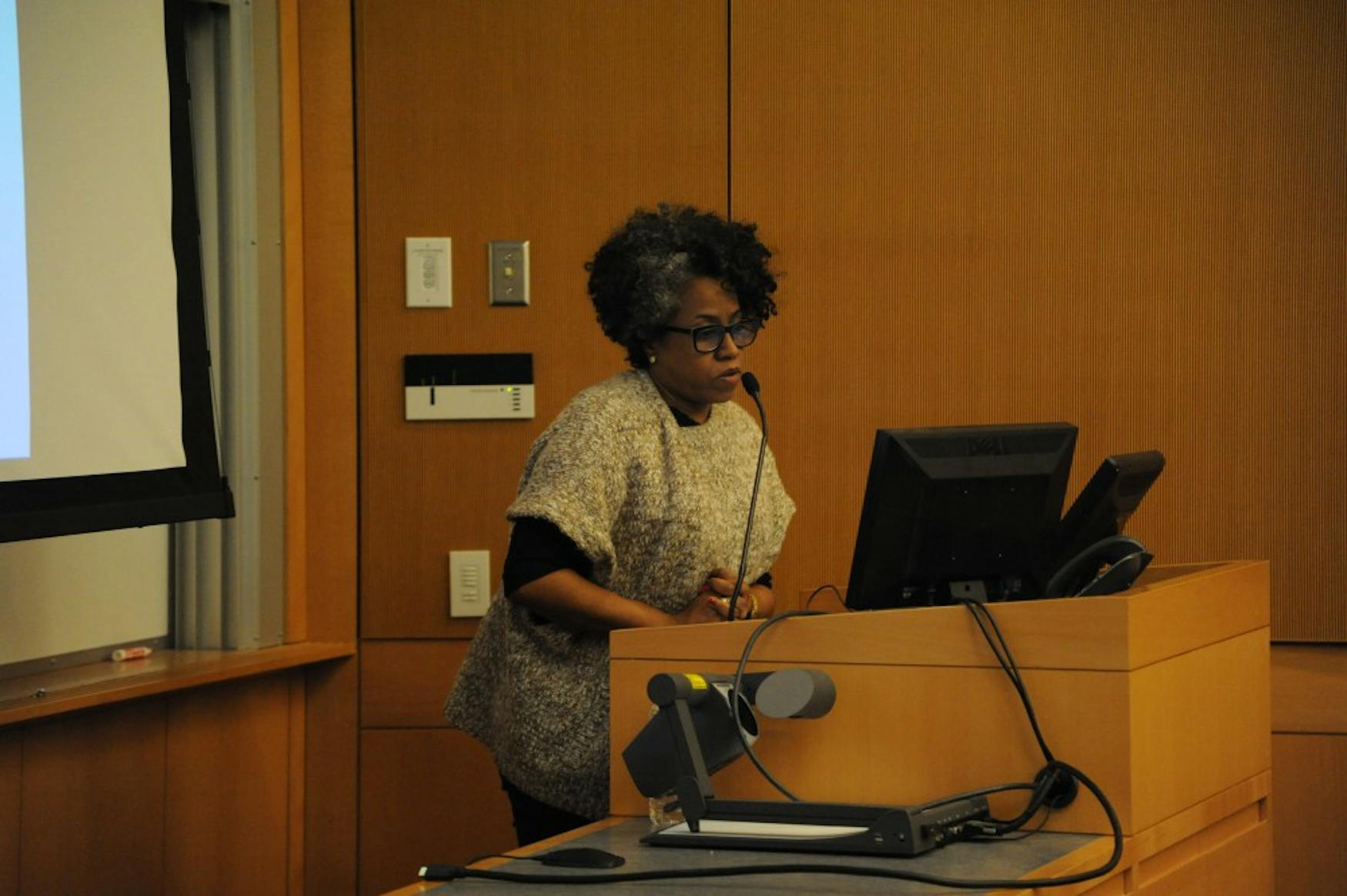Jones outlines jazz’s role in modern art
The Rose Art Museum’s newest Collection in Focus features pieces from artist Jennie C. Jones, who visited Brandeis on Thursday. Jones is known for her work in modern art, in which she incorporates multimedia to create canvas paintings, sculptures and other instrumental works. Her work “Vertical Into Decrescendo (2014)” is hanging in the Mildred S. Lee Gallery along with pieces from the Rose’s collection and the Robert D. Farber Archives & Special Collections.
Much of Jones’ work revolves around the history of black artists in jazz music and jazz’s evolving role in the context of music history. Jones’ work has come to prominence over the past 10 years; most recently, her piece “Five Point One Surround” (2014) was aquired by the Museum of Modern Art in New York.
In her art talk, Jones presented a slideshow featuring excerpts of her work and commented on the thought processes behind the pieces. Before the talk began, students and staff piled into the lecture hall, filling the seats, sitting on the steps leading down podium and standing in rows at the back of the room after all of the seats had been filled.
Jones opened her talk by explaining how a walk with her dog inspired her work with cassettes and memorializing. Walking in Brooklyn, New York, Jones stumbled upon a group of discarded cassettes and began to think about the meaning such a group of cassettes could convey. Later, she bought a bulk set of jazz cassettes, which happened to include a lot of saxophonist Kenny G’s music.
Jones noted that Kenny G was part of the movement that turned jazz from a radical counter-culture act into elevator music, and decided to express this shift in Breathless. Breathless is a series of drawings that uses repurposed audiotapes to make a larger statement about the future of jazz music.
Jones’ Breathless series takes the audiotapes from Kenny G’s cassettes and repurposes them in what Jones characterize as a reclaiming measure. The series takes its name from Kenny G’s 1985 Breathless album.
The pieces consist of the black audiotapes arranged in different ways over 16 by 20 inch white canvases, pressed under class panes. Jones explained that the flowing shapes and structures of the tapes are meant to juxtapose jazz’s organic roots with Kenny G’s more commoditized sound. Jones mentioned that the series—which began in 2008—is ongoing, but that the audiotapes of Kenny G’s album that she bought have almost run out.
Groups of tangled ear buds dipped in white latex accompany the canvases in the series. In her talk, Jones called these pieces “clusterf*cks,” noting that the materials and metaphors are liberating and do not need long, didactic reasoning to be understood. She also mentioned that the record industry itself is somewhat of a “clusterf*ck,” and the ear buds help express that sentiment.
Another one of Jones’ series, Absorb/Diffuse (2011), dealt more with acoustics and sound. The series, which hung in the Kitchen, a New York art gallery, played off of how sounds interact with recording spaces. The piece consists of large black acoustic absorber panels, which Jones called “acoustic paintings.” Jones talked about how there is physicality in the way sound reverberates and how acoustic panels can bounce sound back at the listener.
With this in mind, she composed a jazz score, “From the Low (2011),” and had the score play alongside the paintings. This interplay helped change the quality of the score and create an immersive experience for attendees at the gallery.
Jones also commented on the significance of the echoes, highlighting “what it means for blackness”—in the form of black artists’ music and music inspired by these artists—“to be pushed back at you in this way.”
Jones said that she was surprised when her work started gaining notoriety and works of hers like “Long, Low, Rest (semibreve)” started to show up among the top Google search results for the music term “musical rest.” “Long, Low, Rest (semibreve)” displays a musical rest symbol that spans five white canvases.
The paintings were hung somewhat low on their walls, as if they were part of a musical composition whose other bars were missing. The painting was on view at the Kitchen along with Absorb/Diffuse and “From the Low” in 2011.
Jones ended her talk with a question and answer session, and many of the questions were geared to themes of social justice. One particularly challenging question was whether Jones thinks that she creates art in a black feminist fashion. With a laugh, she said, “I should…sure.” In any event, Jones’ work highlights prominent themes in jazz and black history, and her paintings are sure to make people question their assumptions about music for years to come.



Please note All comments are eligible for publication in The Justice.